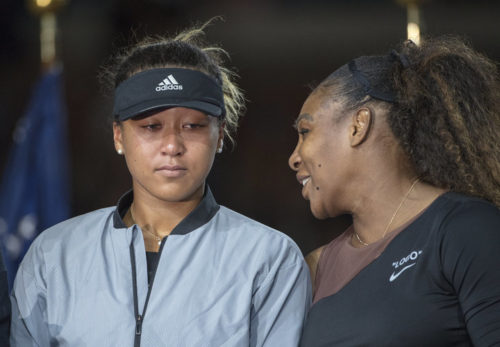The Whitewashing of Naomi Osaka
Share
Explore Our Galleries
Breaking News!
Today's news and culture by Black and other reporters in the Black and mainstream media.
Ways to Support ABHM?
By Zeba Blay, Huffington Post
In a cartoon he drew for Australia’s Herald Sun on Sept. 10, illustrator Mark Knight depicts Serena Williams during the finals match at the U.S. Open Tennis Championships. It’s a classic racist caricature: Williams appears as a hulk-like figure with unkempt hair and large lips reminiscent of the minstrel or the mammy.
Behind Williams is her competitor, Naomi Osaka. Her appearance has been distilled down to its lowest-common-denominator characteristics: light skin, slim frame, blonde hair. She might as well be Maria Sharapova.

2018 US Open Tennis Tournament- Day Thirteen. Naomi Osaka of Japan with Serena Williams of the United States at the presentations after the Women’s Singles Final on Arthur Ashe Stadium at the 2018 US Open Tennis Tournament at the USTA Billie Jean King National Tennis Center on September 8th, 2018 in Flushing, Queens, New York City. (Photo by Tim Clayton/Corbis via Getty Images)
Caricatures, by their nature, are meant to distort and exaggerate. But they’re also meant to be symbolic, representative; short-hand for a concept or idea.
Here, the narrative is clear: Williams has been cast as the big, ugly, angry black woman. Osaka, by contrast, has been cast as the innocent white girl, even though she’s not even white….
Yet Osaka’s biracial identity is inconvenient in a racist narrative that turns Williams into a stereotype. It’s more expedient to focus on all the things about her that aren’t stereotypically black: her light skin, her soft-spoken nature, her tear-filled apology after winning the match. In this way, Osaka is framed if not as a white woman, then as a more acceptable and palatable version of blackness ― as the type of black person that doesn’t make you acknowledge their blackness.
Read the full article here.
Read more Breaking News.
View more galleries from the ABHM here.











Comments Are Welcome
Note: We moderate submissions in order to create a space for meaningful dialogue, a space where museum visitors – adults and youth –– can exchange informed, thoughtful, and relevant comments that add value to our exhibits.
Racial slurs, personal attacks, obscenity, profanity, and SHOUTING do not meet the above standard. Such comments are posted in the exhibit Hateful Speech. Commercial promotions, impersonations, and incoherent comments likewise fail to meet our goals, so will not be posted. Submissions longer than 120 words will be shortened.
See our full Comments Policy here.